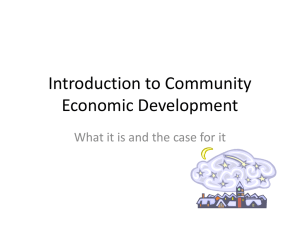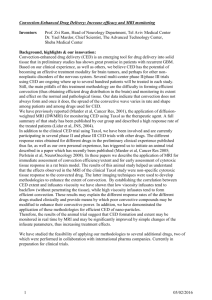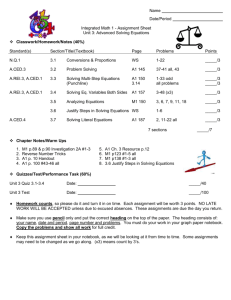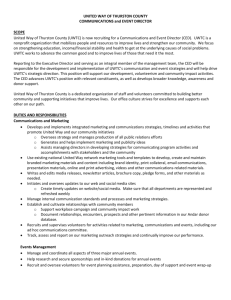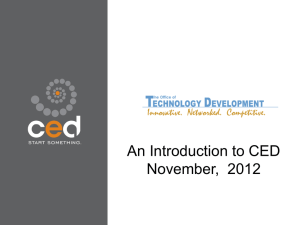Document 10679648
advertisement
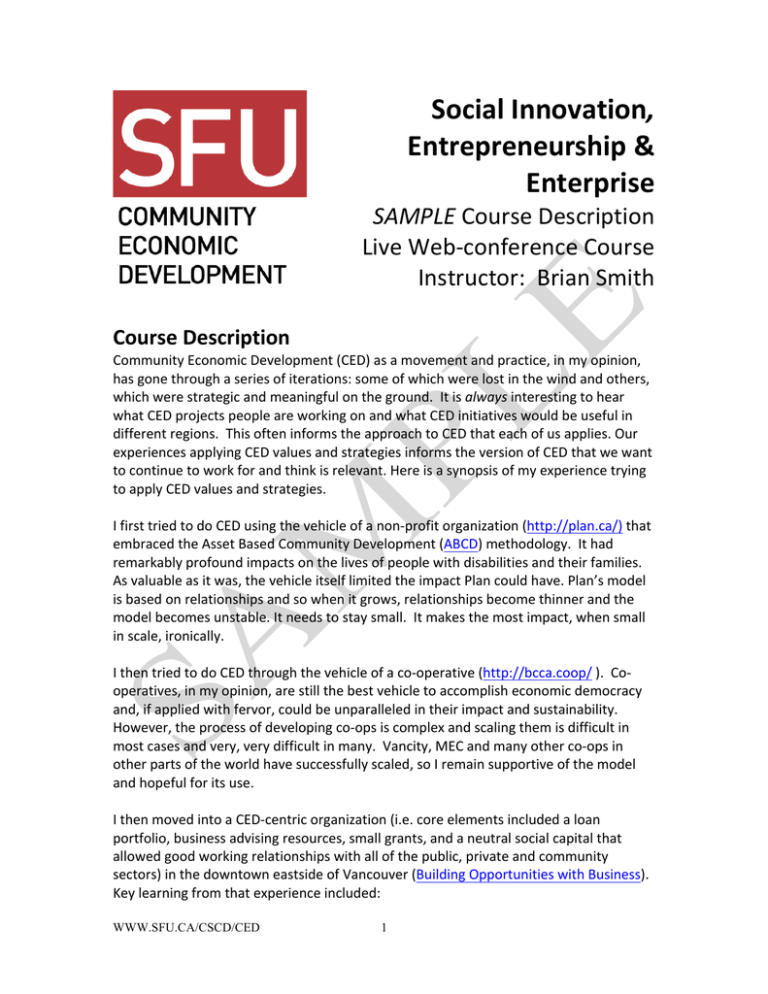
Social Innovation, Entrepreneurship & Enterprise SAMPLE Course Description Live Web-­‐conference Course Instructor: Brian Smith Course Description Community Economic Development (CED) as a movement and practice, in my opinion, has gone through a series of iterations: some of which were lost in the wind and others, which were strategic and meaningful on the ground. It is always interesting to hear what CED projects people are working on and what CED initiatives would be useful in different regions. This often informs the approach to CED that each of us applies. Our experiences applying CED values and strategies informs the version of CED that we want to continue to work for and think is relevant. Here is a synopsis of my experience trying to apply CED values and strategies. I first tried to do CED using the vehicle of a non-­‐profit organization (http://plan.ca/) that embraced the Asset Based Community Development (ABCD) methodology. It had remarkably profound impacts on the lives of people with disabilities and their families. As valuable as it was, the vehicle itself limited the impact Plan could have. Plan’s model is based on relationships and so when it grows, relationships become thinner and the model becomes unstable. It needs to stay small. It makes the most impact, when small in scale, ironically. I then tried to do CED through the vehicle of a co-­‐operative (http://bcca.coop/ ). Co-­‐ operatives, in my opinion, are still the best vehicle to accomplish economic democracy and, if applied with fervor, could be unparalleled in their impact and sustainability. However, the process of developing co-­‐ops is complex and scaling them is difficult in most cases and very, very difficult in many. Vancity, MEC and many other co-­‐ops in other parts of the world have successfully scaled, so I remain supportive of the model and hopeful for its use. I then moved into a CED-­‐centric organization (i.e. core elements included a loan portfolio, business advising resources, small grants, and a neutral social capital that allowed good working relationships with all of the public, private and community sectors) in the downtown eastside of Vancouver (Building Opportunities with Business). Key learning from that experience included: WWW.SFU.CA/CSCD/CED 1 • • • • free money, in the form of grants, have little lasting impact, industry clusters (i.e. allies and competitors working together for common goals and sector-­‐wide progress) can be useful but are hard to predict the return on the investment, being a knowledge hub and conduit of relationships between stakeholders was the single most useful role, and leveraging the loan portfolio had greater potential that realized at first blush. Then I went to work at an established social enterprise (http://www.atira.ca/ ) and learned first-­‐hand that social returns on investment are more 'valuable' than financial returns. Provision of safe housing, care, and employment that meets people where they are at were just a few of the social returns. We borrowed from impact investors such as Vancity Credit Union and Social Capital Partners. That financing – social impact financing -­‐ accomplished social justice in the downtown eastside. To reiterate, finance (not funding) dollars were used to accomplish social justice, as well as economic growth. Until recently, much of the social justice movement has believed (or felt entitled) that only grant/philanthropic dollars could resource social change. Non-­‐profits are now being forced to rethink that assumption and many are exploring or engaging in social enterprise. There are a number of vehicles that can utilize finance for social change. By and large, the only vehicle wherein finance will lead to change is one that applies a business model to manage the operation, remain accountable, and grow. That vehicle could be a social enterprise, social venture, community land trust, community development corporation and more. And so, as Executive Director of Community Futures on the Sunshine Coast, I am encouraging a transition to invest in the entrepreneurs and business models that are capable of returning social, ecological, financial AND economic returns on our investment. A transition to a new model The new iteration of CED is, I believe, represented by this program and exhibited in the language around local, living economies. An important element of a healthy local economy is social innovation built upon social entrepreneurship and social finance. In order to understand this transition, here is what I understand traditional economic development to include: • Business attraction • Business retention and expansion • Business creation (albeit to a lesser extent) WWW.SFU.CA/CSCD/CED 2 And, traditional economic development has three main purposes: • To give a greater number of people greater access to wealth through personal economic growth; • To increase the tax base of communities in order to provide higher quality public services to citizens; • To diversify the economic base and thereby cushion the community against economic shocks. For the past 3 decades many people have worked hard to build CED as a viable alternative to both neo-­‐liberal economic theory and the traditional economic development strategies that derive. The following CED principles are commonly accepted: • Local employment • Local ownership and decision-­‐making • Local economic linkages • Re-­‐investment of profits in communities • Local knowledge and skill development • Positive environmental impact • Health and well-­‐being • Neighborhood stability and community cohesion • Human dignity • Interdepartmental and intergovernmental collaboration “CED is a process by which communities can initiate and generate their own solutions to their common economic problems and thereby build long-­‐term community capacity and foster the integration of economic, social and environmental objectives. CED has emerged as an alternative to conventional approaches to economic development, a participatory, holistic process that leads to positive, concrete changes in communities by creating employment; reducing poverty; contributing to the health of the natural environment; stabilizing local economies; and increasing community control.” (SFU Centre for Sustainable Community Development) Social innovation, like CED, is a process. However, unlike CED, social innovation is positioned as mainstream. Social innovation is grounded in the use of sustainable business models and social finance and thus better positioned than CED to gain traction, spread, replicate and scale. CED has been dependent on grant funding from governments. Many CED advocates saw themselves as intellectually separate from others systems. Conversely, social innovators, entrepreneurs and financiers are looking to work with the existing systems, in new ways. Social innovations, enterprises and finance can and, I believe, will solve the most complex and challenging issues in our communities. WWW.SFU.CA/CSCD/CED 3 Some principles of social entrepreneurship that I like include: • Iterative growth -­‐ Many models can be seed-­‐funded with less than $20k because we start with a pilot or prototype product or service to begin building the market and test assumptions. • Self-­‐funding -­‐ These ventures are decidedly entrepreneurial because they are self-­‐funding rather than being reliant on external funding. • Customers as contributors -­‐ This is the shift from seeing people as needs to be filled and problems to be fixed to seeing people as gifts to be engaged and having contributions to make. • Agile capacity building -­‐ These organizations follow the shifting edge of market opportunities in markets. • Building community -­‐ One of the more salient approaches is to weave social networks within their networks of customers as well as creating more connections between their customers and their communities. • Happiness indicators -­‐ These are the indicators such as appreciation, sharing, learning, aliveness, and simplicity. They are used as design principles in crafting the form, feel, and function of the organization relative to all of its stakeholders. These organizations explicitly make the practices of happiness more possible for its customers, staff, and partners. For social innovations to succeed and scale to have meaningful impact they need an ecosystem that includes: • Champion leaders capable of seeing social change as market opportunities and that relationships are necessary to achieve impact; • A blended value business model (e.g. social enterprise, social venture, community contribution corporation, etc.), and; • Financing that is flexible (e.g. philanthropic loans, patient capital, impact investments, etc.) and that acknowledges and leverages social, ecological, economic and financial ROI. • There are other things needed like policy, social infrastructure, peer networks, etc. however for this course, we’ll focus primarily on the first three. Everyone can be a change-­‐maker, a leader and a champion. What is more, everyone is connected to elements of the ecosystem necessary for successful development of social innovations, implementation and growth of social change and scaling of social impact. Everyone has value to add to a healthy local economy and a role to play in developing it. Course Objectives By the end of the course participants will: • Be introduced to the concepts, values, and applications of social innovation, social entrepreneurship and social enterprise. • Consider the elements and connections that comprise the social enterprise ecosystem. WWW.SFU.CA/CSCD/CED 4 • • • Explore the concept of panarchy and complex adaptive systems. Get acquainted with lean start-­‐up, business planning and business model generation. Learn about new models of funding and financing social change. By the end of the course participants will leave with: 1. Relationships to social entrepreneurs in your community. 2. Knowledge of the types of legal, organizational models (e.g. non-­‐profit, for-­‐ profit, co-­‐op, etc.) accessible to you. 3. Completed business model canvas, a tool that can be used many times over. 4. An analysis of the social enterprise ecosystem in your community. 5. A set of tools (e.g. Business Model Canvas, Tables and Charts, etc.) to organize and support social change. 6. Increased confidence and skills for supporting social innovation. About the Instructor "You simply, and desperately want Brian on your team. Over the past four years, I've seen Brian skillfully navigate one of the most tricky communities in North America. Along they way he galvanizes stakeholders, creates new partnerships, name the strengths in others and encourages them to their potential. Brian's guidance and wisdom assisted my company, Mission Possible, at key junctures enabling us to become one of the most recognizable and respected social enterprises in the City of Vancouver." Brian Postlewait, CEO, Mission Possible. Brian Smith is social finance, innovation and social enterprise executive. His career has spanned the co-­‐op movement and working with people with disabilities to economic development in the downtown eastside of Vancouver. In 2009, he was recognized as one of the Top 40 Under Forty business people in Vancouver. Brian served as the Chief Operating Officer of Atira, a social purpose business with a large staff compliment and annual revenue in excess of $11 million. Brian has co-­‐ founded several enterprises, both for-­‐profit and not-­‐for-­‐profit. He has served as a Director of the Hastings Crossing Business Improvement Association and SOLEfood Farms, both organizations he helped to co-­‐found in the Vancouver’s downtown eastside. Brian is also an avid cyclist, homebrewer, father of three and resident of Gibsons, BC. He sits on the Board of the Gibsons Public Market, the most recent venture, is the Executive Director of Community Futures Sunshine Coast and the owner and CEO of Persephone Brewing Co. WWW.SFU.CA/CSCD/CED 5
